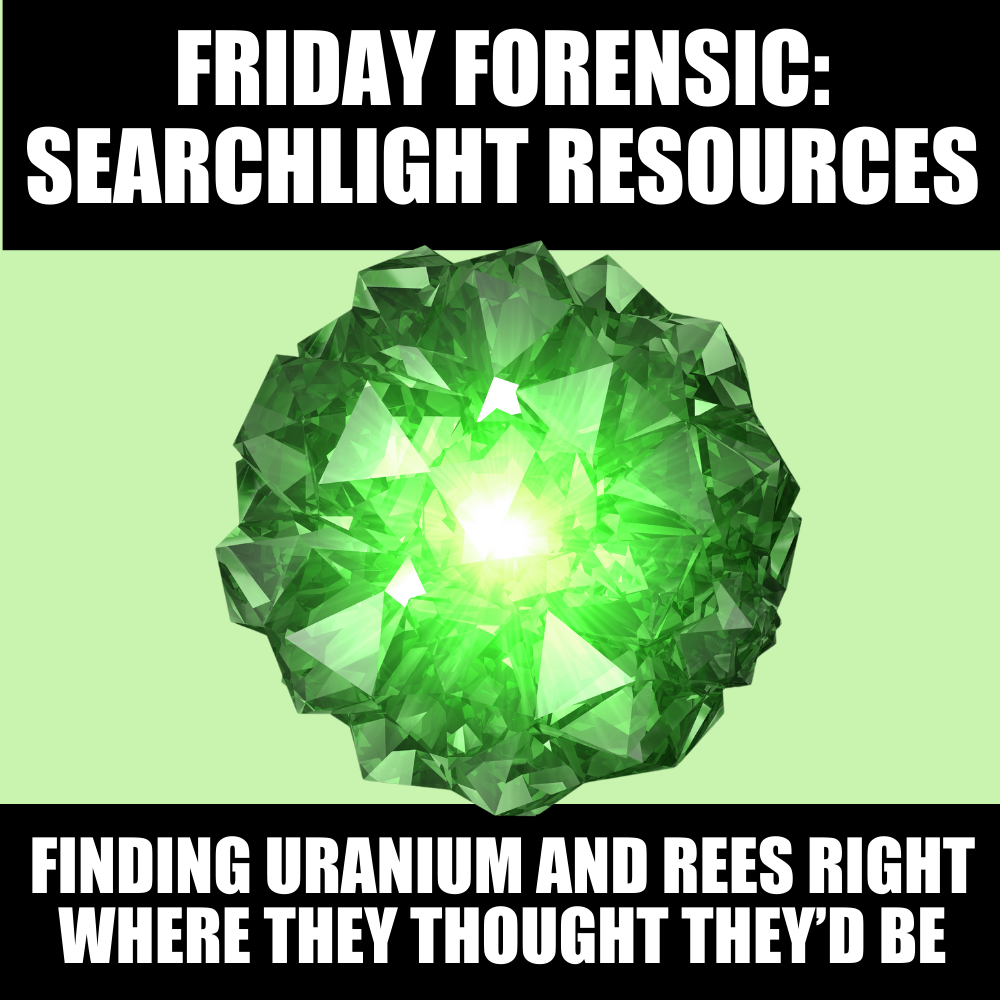In a recent update, Searchlight Resources Inc. (SCLT.V) has announced the results of their mobile metal ion (MMI) surveys conducted on the Kulyk Lake uranium and rare earth project, roughly 75 km northwest of La Ronge, Saskatchewan where, lo and behold, they found. uranium and rare earth elements.
This is not a surprise. It’s good news. It’s progress.
But, if you’re not technically inclined you may be getting ready to hit the backspace button right now, so before we get all into the technical weeds, let’s go to school for a minute and see if we cna’t get you right to the end of this news.
WHAT DOES THIS ALL MEAN
When you’ve got a geologist in your office and she says ‘thar be gold in them thar hills’, your first move as a metals exploration comnpany is to hire a weirdo with a twin prop to fly a radiometric survey over your field and take pictures that hopefully pick up masses of what may be radioactivity.
The ensuing pictures will tell you where to go next to zero in better on the hot spots and, when you do, your next move is the MMI.
Here’s how MMI surveys work:
- Sample Collection: Soil samples are collected systematically from the surface. The sampling is usually done in grids, with spacing varying based on the survey’s objectives and the area’s geological context.
- Extraction of Metal Ions: The collected soil samples are treated with a solution that extracts mobile metal ions from the soil matrix. These ions are metals that have migrated upward from deeper mineralization zones through various geological processes.
- Analysis: The extracted ions are analyzed using sophisticated instruments to determine the concentrations of different metals. The sensitivity of this method allows for the detection of extremely low concentrations of metal ions, and when you put the grids together, you can get a sense of where the metals might be gathered.
- Data Interpretation: The concentration data is used to identify anomalous areas where metal ion levels are higher than the background levels. These anomalies may indicate the presence of buried mineral deposits, which you’d then start drilling to get an idea of EXACTLY what’s there.
SO WHERE DOES THAT LEAVE SEARCHLIGHT?
Searchlight is in the pre-drilling phase, mostly because it’s a little outfit without massive resources, so it tends to take soft, slow inexpensive steps that will progress the property over time.
Back in October 2023, the company expanded on its previous year’s work with new MMI surveys on the western side of Kulyk Lake where two grids were established, extending their 2022 grids with 50-metre spaced sampling. In total, 196 MMI samples were taken in that haul, adding to the 242 samples from a year prior.
The results? Multiple uranium and rare earth element (REE) anomalies with surveys revealing an anomalous zone stretching up to 400 metres at Whalesback Ridge and new anomalies at Hot Ridge. Again, in layman’s terms, “everything is going as planned.”
The results weren’t a total surprise – Both sites were initially flagged by an airborne radiometric survey conducted by Searchlight in 2021, while limited prospecting in 2022 produced grab samples with up to 670 ppm triuranium octoxide (U3O8) and 540 ppm U3O8.
Using our own system that defines these samples in categories of ‘meh’, good, great, or bonanza if they hit appropriate levels, these numbers in an MMI survey are what we’d call ‘GREAT’ in that they’re in the several hundreds of ppm of U308.
On the REE front, the MMI surveys identified significant anomalies at both Whalesback Ridge and Hot Ridge, while confirming the REE zone at Whalesback Ridge aligns closely with the uranium zone, indicating a strong association between the two mineralizations.
Previous samples from Hot Ridge yielded up to 0.95% total rare earth oxide (TREO) which, on our scale, would be defined as ‘GOOD’.
These anomalies align with the Eldorado (uranium) and Fanta (REE) targets on the east side of Kulyk Lake, which are drill-ready, and add another spotlight to what’s been a slow and steady roll towards proving out the entire property.
SO WHAT’S NEXT?
Looking ahead, Searchlight’s exploration plans include more MMI sampling to bridge existing grids, detailed sampling at 25-metre intervals in anomalous areas, prospecting, and geological mapping. Additionally, they plan to conduct airborne radiometric surveys over the entire 212.9-square-kilometre claim block.
To be honest, I’d love to see them shift into drill mode, even in a small way, just to show investors that they have belief in the property, but CEO Stephen Wallace has taken a consistent ‘steady as she goes’ approach thus far that has allowed SCLT to navigate harsh markets better than many of a similar size.
The company is gearing up for a 1,500-metre diamond drilling program targeting the Fanta REE and Eldorado uranium sites soon. Fanta, known for high-grade REEs, has historical results showing up to 56.18% TREO from a monazite outcrop. Eldorado’s past trench results include up to 0.785% U3O8 and 0.208% TREO over 1.1 m and 0.365% U3O8 and 0.459% TREO over 0.25 m.
Either way, the company has been staking new land, selling non-core projects, and breaks the traditional junior miner mode of ‘raise cash constantly and spend like a sailor on Bangkok shore leave.’
Respect to the guys who keep moving, and keep proving.
— Chris Parry
FULL DISCLOSURE: Searchlight is not a client company, though it has been in the past, and we’ve long respected how they do business enough to keep telling you about them.

